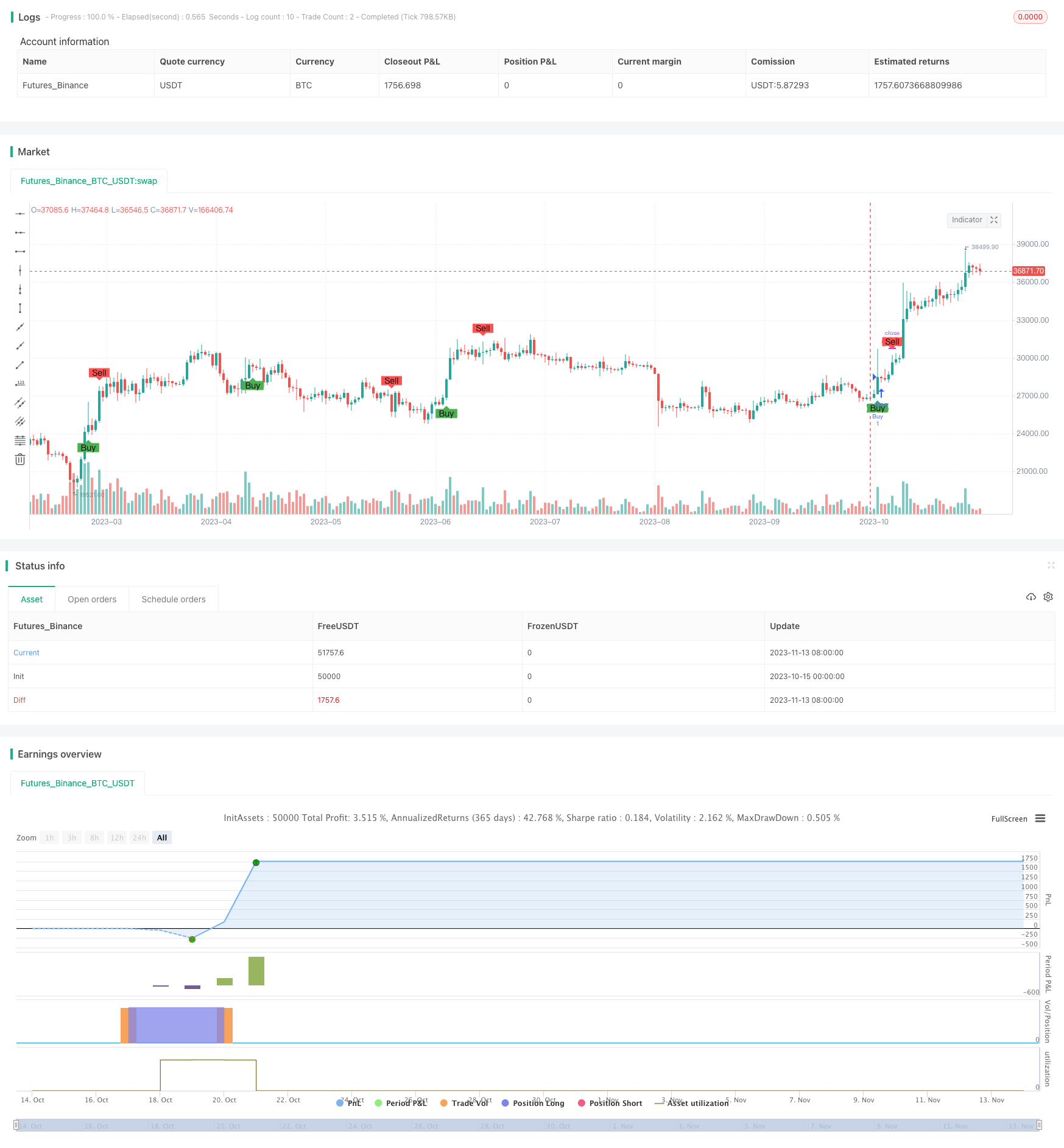
概述
该策略利用双EMA均线形成金叉做多,死叉做空的经典趋势跟随策略,并利用ATR指标和ADX指标进行额外过滤,在强势趋势时进行追踪,在震荡时控制风险。
策略原理
该策略主要基于以下几点:
使用较短期的8周期EMA均线和较长期的20周期EMA均线形成金叉和死叉信号。EMA均线本身具有趋势跟随性质。
ATR指标体现近期波动幅度。通过ATR指标的正态化,可以动态调整EMA均线交叉的过滤条件,在强势趋势追踪时降低要求,在震荡行情时提高过滤要求,控制风险。
ADX指标判断趋势强度。当ADX值大于30时,认为出现强势趋势,此时及时止损防守。
结合涨跌趋势判断做多做空时机。在牛市中,金叉做多,在熊市中死叉做空。
交易量过滤,在交易量放大的时候进行入场。
USD指数简单判断美元强弱,美元强势时止损和止盈幅度扩大。
结合超级趋势指标来判断总体行情走势,辅助判断做多做空时机。
该策略充分结合趋势指标与震荡指标,能够动态调整参数,在追踪趋势的同时控制风险。
策略优势
使用双EMA均线系统进行趋势判断,EMA具有平滑性,可以有效过滤假突破。
ATR指标动态调整EMA均线交叉过滤条件,使策略可以灵活适应不同市场环境。
ADX指标和交易量作为辅助判断指标,避免在震荡行情中被套。
考虑美元指数和超级趋势指标判断大趋势,提高决策的准确性。
风险管理参数会根据美元强弱自动调整,强美元时止损和止盈幅度放大。
使用简单直观的金叉死叉交易信号以及止损止盈策略,容易实现和回测。
策略风险
双EMA均线系统去除趋势临界点判断存在滞后。
ATR参数选择不当可能导致过于激进或保守。
ADX指标参数需要优化,ADX高点选择不当可能错过趋势。
美元指数以及超级趋势指标判断可能存在错误。
止损幅度过小可能增加亏损;止损过宽容易被套。
优化思路
可以考虑结合其他指标如MACD判断趋势临界点。
利用更多历史数据训练ATR参数空间,找到最优参数范围。
测试不同ADX参数、优化ADX高点判断。
增加更多变量判断美元指数和市场总体走势。
根据回测数据计算出最优止损幅度。
可以考虑止损改为移动止损或振荡止损。
继续优化开仓量大小以及持仓周期。
总结
本策略整合经典的双EMA均线系统与多个辅助指标,通过参数自动优化,实现了一个较完整的趋势跟随策略。它能够灵活适应市场环境的变化,在追踪趋势的同时控制风险。但仍需要针对止损和指标参数进行进一步测试和优化,以获得更好的稳定收益。该策略思路值得借鉴和改进。
/*backtest
start: 2023-10-15 00:00:00
end: 2023-11-14 00:00:00
period: 1d
basePeriod: 1h
exchanges: [{"eid":"Futures_Binance","currency":"BTC_USDT"}]
*/
//@version=5
strategy("Refactored Advanced EMA Cross with Normalized ATR Filter, Controlling ADX", shorttitle="ALP V5", overlay=true)
// Initialize variables to track if a buy order has been placed and number of periods since the last buy
var bool hasBought = false
var int barCountSinceBuy = 0
// Define EMA periods
emaShort = ta.ema(close, 8)
emaLong = ta.ema(close, 20)
// Define ATR period and normalization
atrLength = 14
atrValue = ta.atr(atrLength)
maxHistoricalATR = ta.highest(atrValue, 20)
minHistoricalATR = ta.lowest(atrValue, 20)
normalizedATR = (atrValue - minHistoricalATR) / (maxHistoricalATR - minHistoricalATR)
// Define ADX parameters
adxValue = ta.rma(close, 14)
adxHighLevel = 30
isADXHigh = adxValue > adxHighLevel
// Initialize risk management variables
var float stopLossPercent = na
var float takeProfitPercent = na
var float trailingStop = na
// Calculate USD strength (simplified)
usd_strength = close / ta.ema(close, 50) - 1
// Adjust risk parameters based on USD strength
if (usd_strength > 0)
stopLossPercent := 3
takeProfitPercent := 6
else
stopLossPercent := 4
takeProfitPercent := 8
// Initialize position variable
var float positionPrice = na
// Volume filter
minVolume = ta.sma(volume, 14) * 1.5
isVolumeHigh = volume > minVolume
// Piyasa yönü için süper trend göstergesi
[supertrendValue, supertrendDirection] = ta.supertrend(4, 14) // Use a factor of 3 and ATR period of 10
bool isBullMarket = supertrendDirection < 0
bool isBearMarket = supertrendDirection > 0
// Yükselen piyasa için alım koşulu
buyConditionBull = isBullMarket and ta.crossover(emaShort, emaLong) and normalizedATR > 0.2
// Düşen piyasa için alım koşulu
buyConditionBear = isBearMarket and ta.crossover(emaShort, emaLong) and normalizedATR > 0.5
// Genel alım koşulu
buyCondition = buyConditionBull or buyConditionBear
// Yükselen ve düşen piyasalar için farklı satış koşulları
sellConditionBull = isBullMarket and (ta.crossunder(emaShort, emaLong) or isADXHigh)
sellConditionBear = isBearMarket and (ta.crossunder(emaShort, emaLong) or isADXHigh)
// Genel satış koşulu
sellCondition = sellConditionBull or sellConditionBear
// Buy condition
if (buyCondition)
strategy.entry("Buy", strategy.long)
positionPrice := close
hasBought := true // Set the flag to true when a buy order is placed
barCountSinceBuy := 0 // Reset the bar counter when a buy order is placed
// Increase the bar counter if a buy has been executed
if (hasBought)
barCountSinceBuy := barCountSinceBuy + 1
// Calculate stop-loss and take-profit levels
longStopLoss = positionPrice * (1 - stopLossPercent / 100)
longTakeProfit = positionPrice * (1 + takeProfitPercent / 100)
// Final Sell condition, now also checks if a buy has occurred before and if at least 5 periods have passed
finalSellCondition = sellCondition and hasBought and barCountSinceBuy >= 3 and isVolumeHigh
if (finalSellCondition)
strategy.close("Buy")
positionPrice := na
hasBought := false // Reset the flag when a sell order is placed
barCountSinceBuy := 0 // Reset the bar counter when a buy order is closed
// Implement stop-loss, take-profit, and trailing stop
strategy.exit("Stop Loss", "Buy", stop=longStopLoss)
strategy.exit("Take Profit", "Buy", limit=longTakeProfit)
//strategy.exit("Trailing Stop", "Buy", trail_price=close, trail_offset=trailingStop * close / 100)
var label l = na
if (buyCondition)
l := label.new(bar_index, high, text="buy triggered " + str.tostring(usd_strength))
label.delete(l[1])
if (finalSellCondition)
l := label.new(bar_index, high, text="sell triggered " + str.tostring(usd_strength))
label.delete(l[1])
// Plot signals
plotshape(series=buyCondition, title="Buy Signal", location=location.belowbar, color=color.green, style=shape.labelup, text="Buy")
plotshape(series=finalSellCondition, title="Sell Signal", location=location.abovebar, color=color.red, style=shape.labeldown, text="Sell")